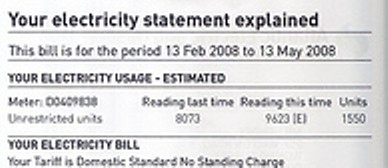
In his wrap up to EnergyCamp last month, David Berlind said something which struck me strongly enough I am still thinking about it.
“The main thing I have learned today is that the wrong people are paying the bill.”
David made the statement in the context that he figures we’re due a 15 year shakeout before we really get a handle on the complexity of carbon and energy consumption and production, so that we can accurately calculate costs and move beyond simplistic economics to better understand the impacts of the decisions we make.
For every believer in food miles and local sourcing there is a New Zealand meat farmer that will argue NZ is a better source of eco-friendly meat because it doesn’t use petrochemical fertilizer on fields sheep graze. Yesterday morning my friend Oliver ribbed Gregor, who was carrying a heavy bag, for using an elevator to go down one floor. Quick as a flash Gregor turned around and said: no its greener to use the lift, because he wouldn’t need to have a shower straight away… (it was a hot Berlin day).
The current commonly cited example in the IT industry of the wrong people paying the bill is facilities management (FM) versus IT. IT doesn’t pay for its electricity. No, seriously, go to your FM manager or IT manager and ask who pays to power your IT properties. The vast majority of IT systems get a free ride on electricity bills, which is one reason its taken so long to fully consider IT carbon costs.
David’s point about the wrong people paying the bill also has a wider context which cuts into issues of sustainability and social responsibility. I was deeply disappointed when the UK Government recently announced the Climate Change aid fund its building to help emerging nations mitigate problems such as rising sea levels, or increased strong weather effects, will actually be loans rather than grants. Who is paying the bill for what here?
The current high costs of food globally, at least partly driven by the new fetish for biofuels, is bound to hurt those those that can least afford it.
Corporate budgeting and planning is generally designed to make costs external. If someone else is paying the bill that helps the bottom line. Pollute a river, and let someone else pay the cleanup costs, is “just good business”. If you think I am just being cynical I would advise you to read or watch a cold-eyed look at the icy hearted sociopath we commonly know as The Corporation.
Economists and company leaders like nothing better than what they call “externalities” -basically costs that someone else has to deal with. Chewing gum is a brilliant example of externalities in action.. It costs 3p a stick, but an esimated 10p to clean it off a city street.
Another way of talking about a less simple economics is to consider Post-Autistic Economics. Autistic economics looks only at the “facts” without understanding social consequences. More heterodox thinking is now entering the mainstreal through, for example, the triple bottom line concept or broader sustainability narratives from major corporations.
The final way I want to think about the wrong people paying the bill concerns our children. The more damage we do right now, the more resources we consume, the more mess we make, the higher the clean up costs will be for the next generation. Even if you believe we can innovate our way out of trouble, large scale clean terraforming is not going to come cheap. We’re externalising the costs of our current lifestyles pretty blithely, and the wrong people are going to get the bill. Economics is many things but simple isn’t one of them. The facilities manager, people living in low lying areas such as Bangladesh, our kids: the wrong people are getting the bill.











